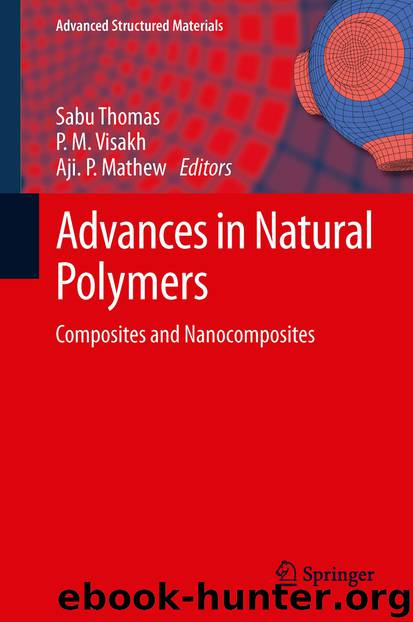Advances in Natural Polymers by Sabu Thomas P. M. Visakh & Aji. P. Mathew

Author:Sabu Thomas, P. M. Visakh & Aji. P. Mathew
Language: eng
Format: epub
Publisher: Springer Berlin Heidelberg, Berlin, Heidelberg
Although alginate hydrogels with versatile properties can be generated through several gel-forming methods, they all involve labor-consuming work in the modification of alginate or the synthesis of an specific cross-linker [54, 55]. A more simple and direct procedure for the synthesis of chemical hydrogels is the Ugi multicomponent condensation reaction on carboxylated polysaccharides [52].
7.3 Properties of Alginates
Alginic acids isolated from different sources can differ in the ratio of mannuronic and guluronic acids (M/G) and in the distribution of the monomers along the polymeric chain. The size and distribution of individual blocks strongly affect the properties of alginic acids and alginates [1].
Its importance manly lies in its hydrocolloid property, e.g., the ability to hydrate in hot or cold water to form viscous solutions, dispersions, or gels. Alginate has been regarded as an excellent polysachaccharide for gel systems because of its unique features such as biocompatibility, biodegradability, immunogenecity, and non-toxicity [56]. Alginates are, in this way, unique in terms of their properties such as emulsifiers, thickeners, stabilizers, gelling and film forming, resulting in several applications for the food and pharmaceutical industries [57].
Download
This site does not store any files on its server. We only index and link to content provided by other sites. Please contact the content providers to delete copyright contents if any and email us, we'll remove relevant links or contents immediately.
| Automotive | Engineering |
| Transportation |
Whiskies Galore by Ian Buxton(41536)
Introduction to Aircraft Design (Cambridge Aerospace Series) by John P. Fielding(32893)
Small Unmanned Fixed-wing Aircraft Design by Andrew J. Keane Andras Sobester James P. Scanlan & András Sóbester & James P. Scanlan(32578)
Craft Beer for the Homebrewer by Michael Agnew(17937)
Turbulence by E. J. Noyes(7708)
The Complete Stick Figure Physics Tutorials by Allen Sarah(7148)
Kaplan MCAT General Chemistry Review by Kaplan(6603)
The Thirst by Nesbo Jo(6444)
Bad Blood by John Carreyrou(6283)
Modelling of Convective Heat and Mass Transfer in Rotating Flows by Igor V. Shevchuk(6229)
Learning SQL by Alan Beaulieu(6041)
Weapons of Math Destruction by Cathy O'Neil(5841)
Man-made Catastrophes and Risk Information Concealment by Dmitry Chernov & Didier Sornette(5659)
Digital Minimalism by Cal Newport;(5396)
Life 3.0: Being Human in the Age of Artificial Intelligence by Tegmark Max(5193)
iGen by Jean M. Twenge(5166)
Secrets of Antigravity Propulsion: Tesla, UFOs, and Classified Aerospace Technology by Ph.D. Paul A. Laviolette(5002)
Design of Trajectory Optimization Approach for Space Maneuver Vehicle Skip Entry Problems by Runqi Chai & Al Savvaris & Antonios Tsourdos & Senchun Chai(4847)
Electronic Devices & Circuits by Jacob Millman & Christos C. Halkias(4752)
